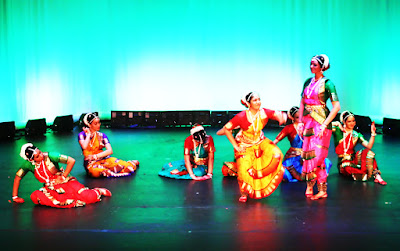Please click here for a slideshow with photos from this program at my blog titled - Boston Arangetram Dance Photography Ganesh
There will be no wisdom, no learning, no art, no craft, no device, nor action that is not found within natya (dance)" - sage Bharata Muni in Natya Shastra ('The Science of Dance', appr. 400 B.C.)
 Vibrant and colorful ethnic costumes, glittering Indian ornaments with intricate detail, hairdos full of flowers, jingling dancing bells, traditional henna patterns, giggling teenage performers - the scene in the dressing room at the MIT Little Kresge Auditorium this past President's Day, 18th February 2008, would have been all too typical and familiar for a stray visitor conversant with any other Indian classical dance program, at least from its outwardly appearance.
Vibrant and colorful ethnic costumes, glittering Indian ornaments with intricate detail, hairdos full of flowers, jingling dancing bells, traditional henna patterns, giggling teenage performers - the scene in the dressing room at the MIT Little Kresge Auditorium this past President's Day, 18th February 2008, would have been all too typical and familiar for a stray visitor conversant with any other Indian classical dance program, at least from its outwardly appearance.Only, MIT Natya's Dancing Nature's Art (an obvious play of words on 'DNA'), unfolds on the stage into a rich, visually spectacular drama that entices the hitherto casual, perhaps curious, viewer into the realms of wondrous and tasteful fusion - of Art and Science; and continues to enthrall her into a stunning visual experience, and further unravels the scientific secrets of the double helix molecule and the science behind how it works to store the human genome data in every cell, through art and human emotion rather than mundane equations and formulae.
Science and art may well have been traditionally considered paradoxical in the mainstream Western thought, but Indian thought had always freely crossed those lines - real or imaginary. In continuation of the spirit of that grand old tradition, MIT Natya, while staying true to the rich traditions of Bharatanatyam, presented the science of DNA by depicting replication, transcription, translation, mutations, evolution and ultimately the immense genetic variety which arises from this tiny molecule, to wide acclaim, culminating into a unique, mutually stimulating interdisciplinary fusion that kindles a sense of unconventional perception and appreciation among the viewers.
The opening act starts with the Bharatanatyam tradition of a prayer followed by a vigorous dance composed of rhythmic footwork (Mallari), continues to take an artistic look at the origin of life, and ends with a theoretical introduction of the evolution of DNA, the molecule of life.
The program then continues to demonstrate the traditional Hindu evolution theory of the 'Dasavatar', the 10 forms of Lord Vishnu, representing the incremental stages in the evolution of life, employing the rich repertoire of the Indian Classical Dance of Bharatanatyam like Jathis, Hasta , Mudras and Abhinaya, to convey a thorough, visually stimulating explanation of complex scientific concepts relating to DNA replication, structure, transcription, translation and mutation with the performers adhering to the grammar, form, rules and abstraction, while employing the dance language as their natural mode of expression.
In an intense celebration of the human creative drive, the program picks an abstract theme and dissects it in a convincingly revolutionary way that manages to easily navigate the albeit imaginary boundaries between art and science using creative metaphors from ancient Indian tradition, and to convey complicated ideas relating to modern scientific subjects like the genome in a skillful display of sheer creativity.
This fresh look at a complex scientific idea through innovative, artistic lens enhances the visual experience of pleasure and the depth of the scientific understanding. Dancing Nature's Art provides something beyond a regular Indian classical dance perforamance experience - it sets a new standard for tasteful and thoughtful, interdisciplinary and intercultural collaboration that allows viewers to feel the richness of ancient Indian art in the context of modern science.
The talented and energetic group of Bharatanatyam students of varying levels at MIT Natya have achieved a vibrant synergy in this unique performance where the aesthetics remained unclouded by the conditioned attitudes, setting an example of what Bharatanatyam training can be when it is treated as more than a means of churning out a byproduct for an arangetram.
The music, composed especially for the production, and recorded by Prasanna & Lalgudi G.J.R. Krishnan, with lyrics by Padmashri Vairamuthu, fusing a wide variety of musical styles and expression, was tastefully used to appropriately support the impressive choreography.
This piece was originally created in 2004 by dancers working under the guidance of dance teachers Ranjani Saigal and Kausalya Srinivasan and Dr. Balram Singh , Professor of Biochemistry at University of Massachussets at Dartmouth, MA.The original production was inspired by Amrita Saigal who had played a major role in the original production. She brought the piece to MIT Natya and along with Renuka Ramanathan and Chandini Valiathan enhanced the original production with new choreography. As the lighting designer, Renuka exceled in creating the perfect lighting for each scene that added to the magic of the creation.
Bharata Muni was right on, after all!! There will, indeed, be no wisdom, no learning, no art, no craft, no device nor action that is not found within natya.
The performers indeed deserve the standing ovation they got from the full house:
Dancers:
Krishna Dahya
Mohini Jangi
Jayanthi Jayakumar
Amrita Karambelkar
Sonya Makhni
Samiksha Nayak
Shriddha Nayak
Renuka Ramanathan
Amrita Saigal
Chandni Valiathan
(This article originally appeared on Lokvani.com at http://www.lokvani.com/lokvani/article.php?article_id=4699)
Please click here for a slideshow with photos from this program at my blog titled - Boston Arangetram Dance Photography Ganesh
More information on MIT Natya can be found at http://web.mit.edu/natya/www or over email at natya-exec@mit.edu



